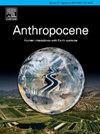人类与气候相互作用对印度半岛最大流域河流洪水特征的影响
IF 3.3
2区 地球科学
Q2 ENVIRONMENTAL SCIENCES
引用次数: 0
摘要
在全球范围内,超过五分之一的人面临百年一遇的洪水风险,特别是在低收入地区。洪水风险正在上升,特别是在人口密集的发展中经济体和气象条件极端的地区。洪水造成重大的经济和健康影响,突出了抗洪社区和备灾的迫切需要。决策者必须了解洪水风险的区域和时间分布,以制定有效的预防和缓解战略。人类活动,如水坝和水库的运作,已经被证明在许多地区降低了洪水的强度,尽管它们的影响因地理和目的而异。本研究调查了印度半岛最大的河流流域哥达瓦里流域的洪水动态,该流域受到大型水坝和水库的显著影响。利用峰值超过阈值(POT)方法、广义帕累托分布(GPD)和CUSUM时间序列分析,分析了洪水的峰值、体积和持续时间等特征。研究结果表明,中东部(万甘加子流域)和东部(因德拉瓦蒂和萨巴里子流域)地区是下游地区洪水量、峰值和持续时间增加的主要贡献者。相比之下,哥达瓦里西部和中西部地区的特点是有许多水坝,由于水坝的运行和温和的气候条件,经历了较小的洪水量,峰值和持续时间。然而,哥达瓦里中东部和东部的无水坝地区缺乏防洪基础设施,气候条件恶劣,面临大规模洪水的高风险。这些发现为了解区域洪水特征和影响因素提供了重要见解,为哥达瓦里盆地制定有效的洪水管理策略提供了支持。本文章由计算机程序翻译,如有差异,请以英文原文为准。
Human versus climate interactions on riverine flood characteristics in the largest Indian Peninsular basin
Globally, over one in five people face 100-year flood risk, particularly in low-income regions. Flood risk is rising, especially in densely populated developing economies and areas with extreme meteorological conditions. Floods cause significant economic and health impacts, highlighting the urgent need for flood-resistant communities and preparedness. Policymakers must understand the regional and temporal distributions of flood risk to develop effective prevention and mitigation strategies. Human activities, such as dams and reservoir operations, have been shown to reduce flood intensity in many areas, though their impact varies by geography and purpose. This study investigates flood dynamics in the Godavari basin, the largest river basin in the Indian peninsula, significantly affected by large-scale dams and reservoirs. Using the Peaks Over Threshold (POT) method, generalized Pareto distribution (GPD), and CUSUM time series analysis, we analyzed flood characteristics such as peak, volume, and duration. Our results reveal that the east-central (Wainganga sub-basin) and eastern (Indravati and Sabari sub-basins) regions are major contributors to increased flood volume, peak, and duration in downstream areas. In contrast, the western and west-central Godavari regions, characterized by numerous dams, experience smaller flood volumes, peaks, and durations due to dam operations and moderate climatic conditions. However, undammed regions in the east-central and eastern Godavari, lacking flood control infrastructure and experiencing severe climatic conditions, face large-scale floods with high risk. These findings offer critical insights into regional flood characteristics and factors, supporting the development of effective flood management strategies for the Godavari basin.
求助全文
通过发布文献求助,成功后即可免费获取论文全文。
去求助
来源期刊

Anthropocene
Earth and Planetary Sciences-Earth and Planetary Sciences (miscellaneous)
CiteScore
6.30
自引率
0.00%
发文量
27
审稿时长
102 days
期刊介绍:
Anthropocene is an interdisciplinary journal that publishes peer-reviewed works addressing the nature, scale, and extent of interactions that people have with Earth processes and systems. The scope of the journal includes the significance of human activities in altering Earth’s landscapes, oceans, the atmosphere, cryosphere, and ecosystems over a range of time and space scales - from global phenomena over geologic eras to single isolated events - including the linkages, couplings, and feedbacks among physical, chemical, and biological components of Earth systems. The journal also addresses how such alterations can have profound effects on, and implications for, human society. As the scale and pace of human interactions with Earth systems have intensified in recent decades, understanding human-induced alterations in the past and present is critical to our ability to anticipate, mitigate, and adapt to changes in the future. The journal aims to provide a venue to focus research findings, discussions, and debates toward advancing predictive understanding of human interactions with Earth systems - one of the grand challenges of our time.
 求助内容:
求助内容: 应助结果提醒方式:
应助结果提醒方式:


